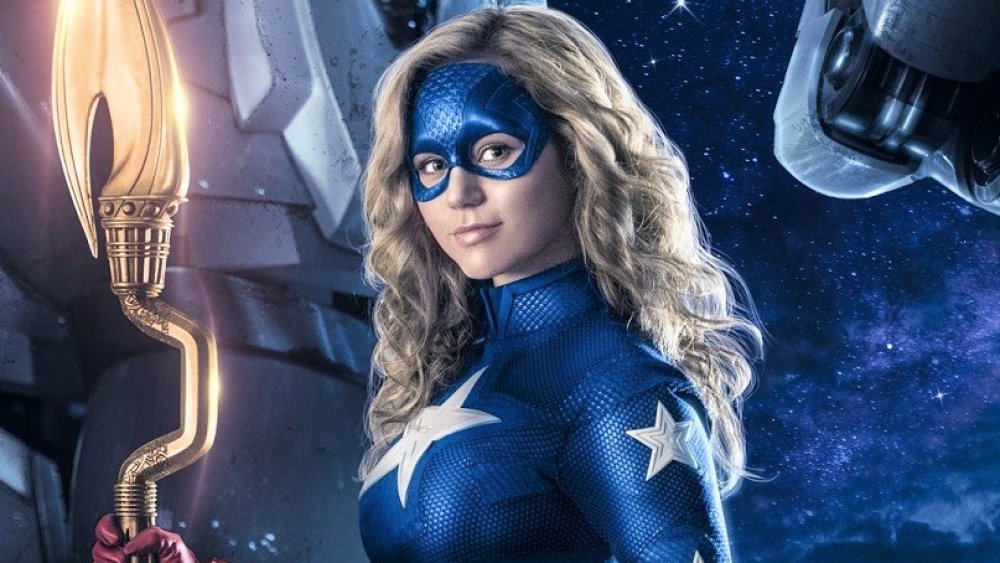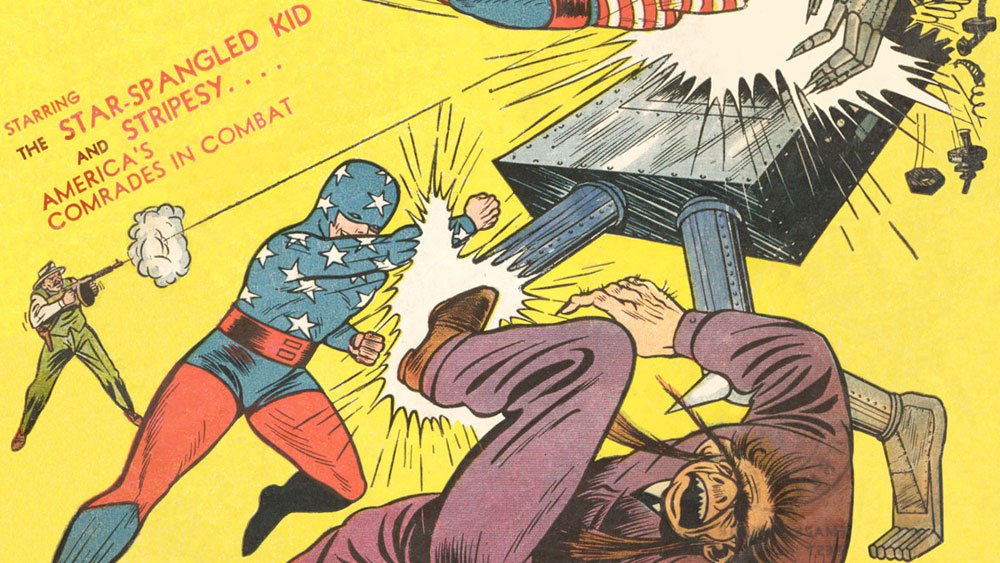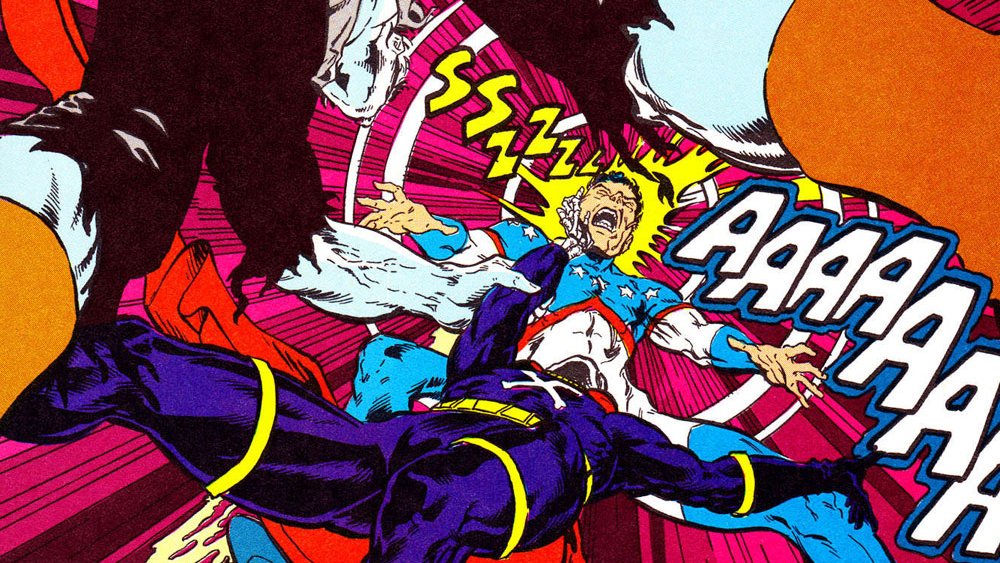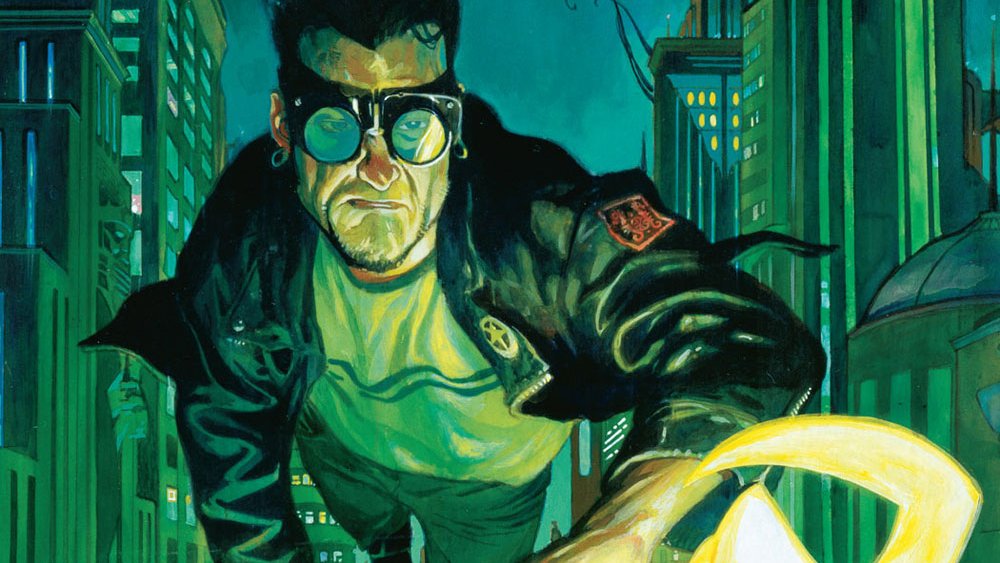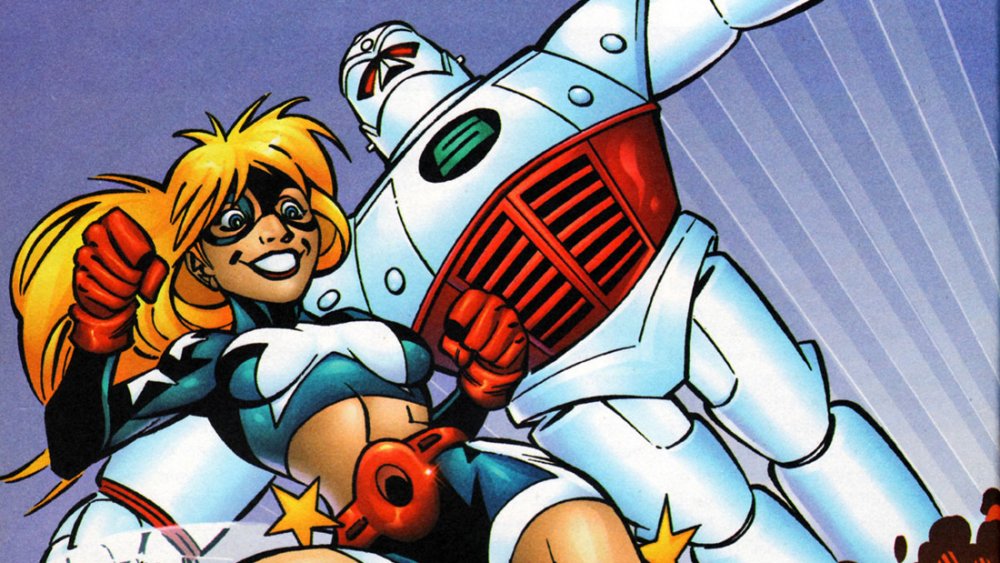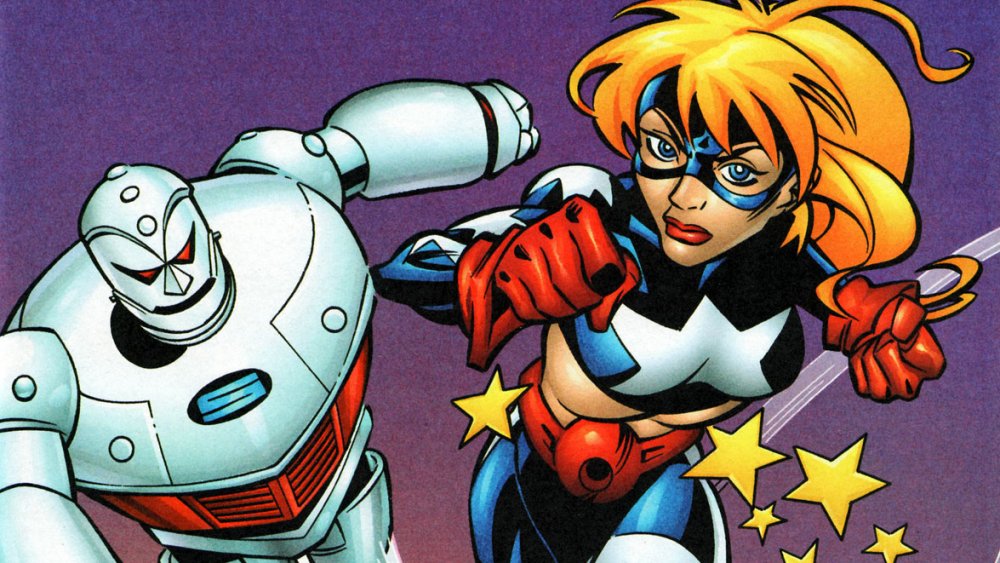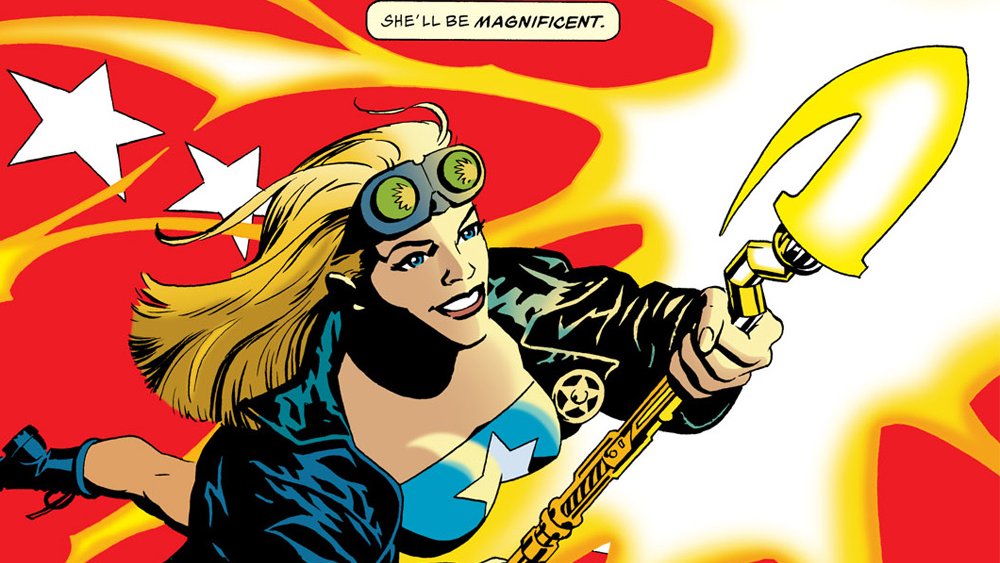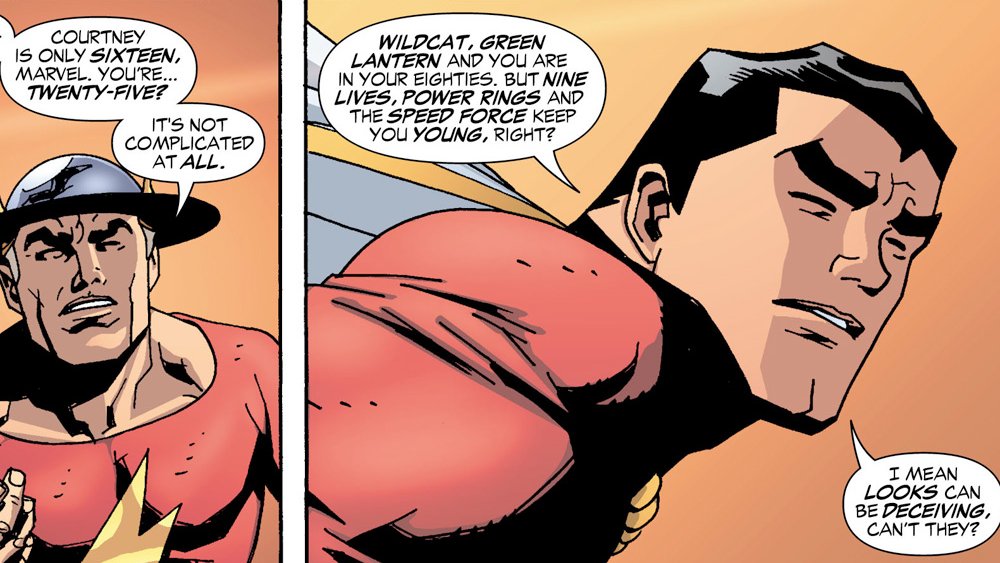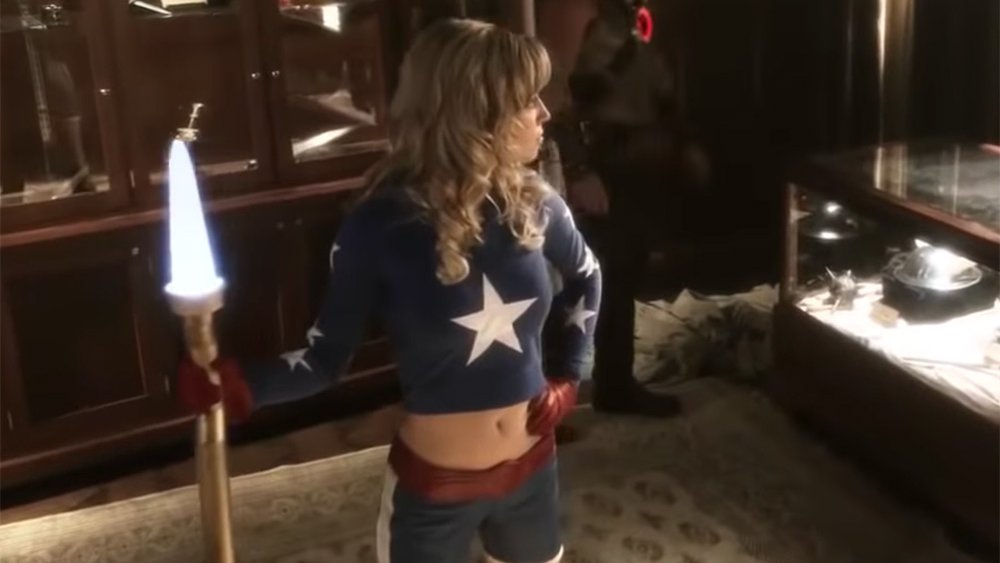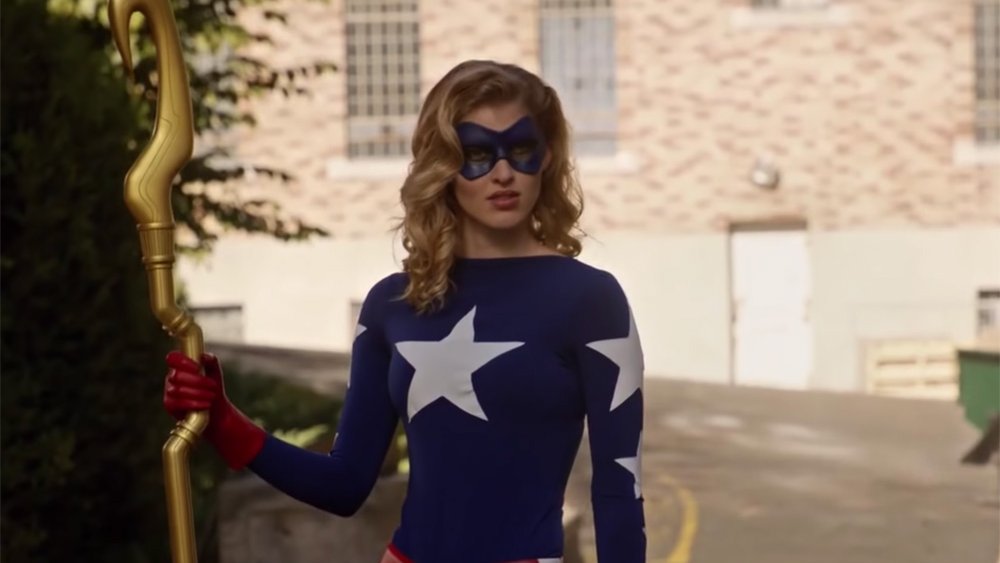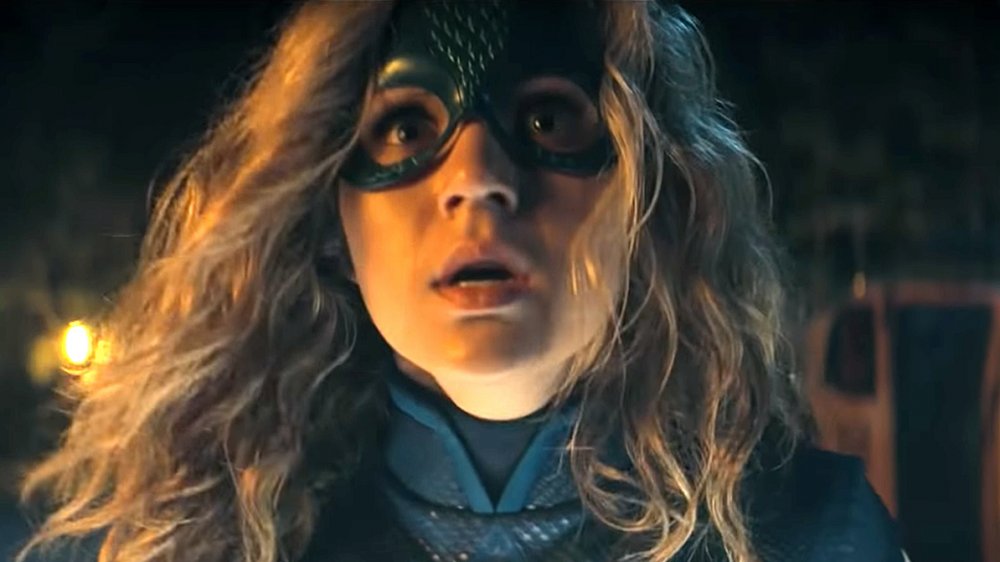The Untold Truth Of Stargirl
When it comes to the DC superheroes, the world of movies has always belonged to the big names. Superman and Batman have had multiple long-running franchises, but when lower-tier characters like John Constantine have been given a shot at the big screen, it hasn't always gone well. The small screen, however, has offered up plenty of opportunity in recent years for great but lesser-known heroes to step into the spotlight. The Flash, Black Lightning, Green Arrow, and even bigger names like Supergirl and Batwoman have all found success in their own shows, with sprawling supporting casts and the ensemble of Legends of Tomorrow giving plenty of others a chance, too.
The next DC character set for stardom, so to speak, is Stargirl, and while she might seem like an unlikely pick, fans of DC Universe deep cuts are pretty excited to see her get a second chance at the spotlight two decades after her single short-lived comic was canceled. If you're curious about how Courtney Whitmore went from obscurity to her own show — and how she's carrying on a tradition of heroism that stretches back a solid 80 years — then read on for the real truth behind DC's Stargirl.
Stargirl's Golden Age Legacy
Like a lot of great DC Comics characters who made their debuts in the '90s, Courtney Whitmore is carrying on a legacy that goes all the way back to the 1940s. In fact, she's actually carrying on two of them, but we'll get around to the other one in a minute.
Before she was Stargirl, Courtney was known as the Star-Spangled Kid, and before she had that identity, it belonged to Sylvester Pemberton, a hero who made his debut in the pages of 1941's Star-Spangled Comics #1. Like a lot of heroes at the time, he and his sidekick Stripesy — Stars and stripes, get it? Like the flag? — were riffing on characters who were already popular in hopes of riding that Golden Age boom to fame and fortune. In this case, they were a patriotic take on Batman and Robin. After all, they were a fabulously wealthy crimefighter and his sidekick who battled against evil with no super powers other than an incredible talent for hand-to-hand combat and an extremely cool car. There was, however, one neat little twist to the gimmick that set them apart from the more popular dynamic duo. This time, the kid was the star, and the grown-up was the sidekick. Sylvester was the teenage heir to the Pemberton family fortune, and Stripesy was actually Pat Dugan, his rough, two-fisted chauffer.
All things considered, they had a pretty successful run in the '40s, but they started going through some rough times before the end of the decade. For one thing, they were eventually shoved out of their own book by a character who was introduced to be their sidekick — Merry, the Girl of 1,000 Gimmicks — and for another, they were members of a team called the Seven Soldiers of Victory who, unless you're a big fan of DC deep cuts, you probably haven't heard of. Stripesy would fall by the wayside as the the years went on, but Sylvester would wind up with a much more tragic end.
Skyman and the Swamp Zombie
The one big problem with characters who showed up during the '40s and had their origins tied to World War II is that, as time passes, it gets increasingly difficult to explain why they haven't aged in the past 70 years or so. This leads to some pretty interesting ways of creators getting around it. Captain America, for example, has the "man out of time" concept of being frozen in a block of ice for however long it's been since the war, and DC's Justice Society of America were depicted as having been exposed to mystical energies that slowed down their aging.
Anyway, for the Star-Spangled Kid, Stripesy, and the rest of the Seven Soldiers of Victory, the explanation was that they'd all been caught up in a time warp back in 1948, a neat little device that also explained why no one was making any comics about them in the intervening years. When he emerged, Sylvester took the name Skyman and began using the "Cosmic Converter Belt" that gave him super powers. As Skyman, he teamed up with the children of some Golden Age characters to form a group called Infinity, Inc., a new generation of heroes to face down a new generation of threats. It went really well, too! For about 50 issues!
And then came Infinity Inc. #51. As part of an extremely complicated plot, a villain called the Harlequin crashed a wedding alongside Solomon Grundy, an undead monster who crawled out of a bog. In the ensuing fight, Grundy grabbed a hero called Mr. Bones and then shoved Bones' hand against Skyman's face. The problem? Well, among Bones' super powers were transparent skin and organs that made him look like a skeleton — hence the name — and a "cyanide touch" that killed instantly, leaving a distinct burn on his victims. In other words, Pemberton got his face burned off by a swamp zombie using a skeleton as a weapon, and while that's probably the most metal way to die, it's also a sad end for an obscure hero.
Of course, it was only the end for Skyman. The Star-Spangled Kid still had a long way to go.
Enter Starman
In the '90s, there was a trend at DC comics of dusting off long-forgotten heroes and breathing new life into them. After all, the idea of heroic legacies had been a part of the universe for a while. Virtually every major DC character in the '90s other than Superman and Batman were part of a heroic lineage, and even Wonder Woman was retconned into being the daughter of the Wonder Woman who was hanging out with the JSA in the '40s. But at the end of the decade, there was a specific interest in reviving the Golden Age. It makes sense that there would be, too. Neil Gaiman's Sandman, which originally started as a new take on the '40s hero of the same name before meandering off into dreamland, was a huge success, and Starman, from James Robinson, Tony Harris, and Peter Snejbjerg, was a cult favorite that still stands out as a highlight of the decade.
The name "Starman" had been used several times at DC over the years, with the first being the Golden Age hero Ted Knight, who used a "Cosmic Rod" powered by strange interstellar energy to fly through the air and zap bad guys. The Starman title that launched in 1994 picked up with his son, David, who proudly carried on his family's tradition of heroism for roughly 45 minutes before he was shot and killed on his first night as a superhero. With David murdered, the legacy fell to Ted's other son, Jack, a sullen Gen X hipster with cool tattoos who had absolutely no interest in becoming a superhero and just wanted to be left alone with his antique collection.
The story of Jack Knight's extremely reluctant heroism wove its way through a huge amount of forgotten DC Universe continuity that dated back to the '40s and tied it all together in a really interesting way. It even unified all the different Starmen — including two different alien princes, a teenager from the 31st century, and some dude from the '80s that nobody liked — into the same legacy. Along the way, Jack upgraded the flashlight-sized Cosmic Rod to a five-foot Cosmic Staff, and he found himself raising his own son, which led him to retire from the superhero business so that he could focus on his family. Oh, and he also met a young woman named Courtney Whitmore, who had no relation to the Knight family or their legacy. Yet.
The all-new Star-Spangled Kid
In 1999, DC launched another one of those books that dusted off an old concept: the Star-Spangled Kid. This time, though, it was in a very different form, thanks to Stars and S.T.R.I.P.E., from rising talents Geoff Johns and Lee Moder.
Remember Pat Dugan, the bumbling but ridiculously strong grown-up sidekick who'd fought crime alongside the original Star-Spangled Kid as Stripesy? Well, it turned out that in the years since he'd returned from being lost in time with the other Soldiers of Victory, he'd retired from superheroics (mostly) and settled down with a woman named Barbara Whitmore. Unfortunately, he didn't get along with his new stepdaughter, Courtney. When Courtney discovered the relics of his superhero past, she stole the aforementioned Cosmic Converter Belt and went into action as the all-new Star-Spangled Kid, initially motivated purely by teenage rebellion.
In order to keep tabs on her, Pat — who it turned out was a gifted mechanic, not the bumbling idiot that he'd been back in those stories from the '40s — deployed his secret project: a massive suit of robotic power armor called the Special Tactics Robotic Integrated Power Enhancer, or S.T.R.I.P.E. With that, the classic duo was reunited in a brand new form, and the stage was set for a character who would become one of DC's most underrated heroes.
Stars and S.T.R.I.P.E.
Stars and S.T.R.I.P.E. only lasted 14 issues before being canceled in December 2000, but it wasn't just a fun, short-lived superhero title. In an era where DC was loaded up with fantastic, under-the-radar gems, from Chase to Aztek to Young Heroes in Love, Stars and S.T.R.I.P.E. was one of the best, and its main hero was arguably the single best character created by Geoff Johns in a career at DC that would wind up lasting decades.
Part of that was likely due to Johns having a very personal investment in the character. Courtney Whitmore was named for and partly based on Johns' sister, who tragically died in an airline accident in 1996. In drawing on that inspiration, Johns and Moder created a character who was cheerful and optimistic while still being unflinchingly dedicated to standing up for what was right and having enough of an edge that she never seemed like an overly peppy Pollyanna.
It probably would've been very easy for a teenager who became a superhero specifically to piss off her stepdad to come off poorly, but she doesn't. And the book might've been short-lived, but it was full of fun action and interesting characters, and the father-daughter relationship at the core of the comic was one that we don't really see that often in superhero stories. The evolution of Pat and Courtney's relationship and how it moves from adversarial "you're not my real dad" rebellion to respect and love is genuinely great.
Starman passes on the mantle
It would've been easy for Courtney Whitmore to fade into obscurity after the end of her series, but like the tenacious character that she is, she managed to stick around. Like most throwbacks to the Golden Age, she wound up joining the Justice Society for a while, being one of a few younger members who were tasked with hanging out with crimefighting senior citizens. The nice thing about that, one assumes, is that they were all in bed by nine, but she probably had to put up with a lot of questions from Wildcat and the original Flash about how to "Facebook me a picture from an email."
It was while she was with the Justice Society that Courtney got caught up in the Sins of Youth crossover that ran in Young Justice. The basic idea was that heroes swapped ages with their sidekicks. The Justice Society, as the oldest heroes, became a pack of troublemaking toddlers, while Courtney herself was aged up into an adult "Starwoman" tasked with keeping track of them all. During that time, she used Jack Knight's Cosmic Staff (along with his signature leather jacket and goggles), which turned out to be way more significant than, say, a grumpy teenage Bruce Wayne dressing up as Robin.
In the final issue of Starman, Jack Knight tied up all the loose plot threads that had been running through his book for the past seven years, and arguably the most important — at least as far as the larger DC Universe was concerned — was passing on his own legacy to the next generation of heroes. Jack and Courtney had never really gotten along, owing largely to Jack's longstanding resentment for his father's attempt to pass down the Starman legacy to Sylvester Pemberton and the way their own teenage rebellions took them in opposite directions. The glimpse he got of Courtney in Sins of Youth however, where he saw what she'd be like as an adult, made him realize that she was the person who should be carrying his legacy forward.
With that, Courtney left the identity of the Star-Spangled Kid behind, taking up Jack's cosmic staff as Stargirl.
Stargirl's bad romance
As mentioned before, Courtney Whitmore spent some time in the revived Justice Society of America, a team that upheld the legacy of both its original founders and the newer incarnations of pretty much every other hero who had been around in the '40s. It was while she was a part of that team that she met and began a romantic relationship with one of the most notable icons of the Golden Age: Billy Batson, aka Captain Marvel, but better known these days as Shazam. This would end up being not only the weirdest piece of Stargirl's history but probably one of the weirdest pieces of Billy's. And considering his arch-nemesis is a talking, telepathic caterpillar from space, that's saying something.
The issue here was that Courtney was 16 years old. For the readers, that's not actually a big deal at all. We all know that Billy is also a teenager, and that it's just the magic word and the thunderous boom of a lightning bolt that gives him the body of an adult when it's time go go do magical superhero stuff. Unfortunately for these two star-crossed lovers, the rest of the Justice Society was completely unaware of this fact. Courtney herself only found out when they were on a mission together that saw Billy briefly lose his powers. To them, they were just a couple of good-hearted teenagers having fun, but to the rest of the JSA, it seemed like this Zachary Levi-lookin', grown-ass man with Superman powers was dating their very underage teammate.
Eventually, it got to the point where Jay Garrick, the original Flash, confronted Shazam about the relationship in JSA #59 and demanded some answers. Rather than just telling Grandpa Flash what the deal was, Billy decided that it was better to just quit the JSA and have the entire team think that he was a pedophile in order to keep his identity a secret from some of the most trustworthy heroes of all time. He also broke it off with Courtney in the same issue, explaining that while he truly cared about her, he didn't want to run the risk of having the team treat him poorly because he was a teenager with super powers. The team that, you know, had multiple teenagers with super powers, including the one he was talking to at that moment, and who were now probably going to tell Superman that he was a child predator the next time they got together with the Justice League for Thanksgiving.
The Wisdom of Solomon ain't exactly what it's cracked up to be, folks.
Stargirl hits the screen
For a relatively obscure, cult-favorite-at-best character who only starred in one comic — where she was technically only one of two title characters — which was canceled 20 years ago after only 14 issues, Courtney Whitmore has made a surprising number of appearances in the world outside of comics. There's a reason for that, though, and it goes beyond just the fact that Stargirl's an interesting character with a simple, iconic look that translates well to live-action. It probably has more to do with how Geoff Johns went from writing that short-lived comic to being promoted all the way to Chief Creative Officer of DC Comics from 2010 to 2018, where he took an active role in shaping the film and television side of things. When you're a character co-created by and based on a relative of one of the people making decisions about who gets to be on TV, you have a much easier time getting on the screen than, say, Doctor Fate.
Both Courtney and Pat Dugan (as S.T.R.I.P.E.) showed up on Justice League Unlimited alongside the other modern incarnations of the Seven Soldiers of Victory, and as a solo act, Stargirl has made appearances up on multiple animated series. She was briefly seen on Batman: The Brave and the Bold, and more recently, she's been featured on Justice League Action and Young Justice: Outsiders, although she's not a superhero in that last one. Instead, she's the host of a celebrity-focused TV show called Stargirl. And in that series, Courtney Whitmore is weirdly voiced by Whitney Moore, which is sort of like if Spider-Man were played by Park Peters.
In live-action, Stargirl played a big role in Smallville's two-part "Absolute Justice" event, which dove into the history of the Justice Society and the idea of Clark Kent carrying on a heroic legacy that dated back to 1940. In this world, Courtney, played by Britt Irvin, took the identity of Stargirl after Sylvlester Pemberton was killed, with the idea that he'd been part of a team of heroes who were branded as criminals as part of a government conspiracy.
Legends of Stargirl
In a massive and truly wild departure from her comics history, Stargirl showed up on Legends of Tomorrow where she was played by Sarah Grey. At first, it was pretty basic stuff. Like in Smallville, she was tied to the Justice Society, although here it wasn't as a legacy character. Instead, she was a founding member back in World War II, essentially replacing both Sylvester Pemberton and Ted Knight in the Arrowverse's version of that era, swapping out both of those characters for a more interesting one with a modern design sensibility.
So far, so good, but that's where things start to get weird, even by superhero standards. It starts with the Spear of Destiny, which is supposedly the spear that a Roman soldier named Longinus used to stab Jesus during the crucifixion. Understandably, it's become a legendary artifact in superhero stories with various powers. For example, in DC continuity, Hitler's possession of the spear gave him the ability to mind-control anyone with powers, explaining why the superheroes didn't just go win World War II before all the bad stuff happened. And it's also a big part of Legends of Tomorrow's second season.
On the show, the spear was so powerful that the heroes broke it into four pieces and scattered it throughout the time stream. Stargirl wound up taking a fragment of it back to the 6th century, where she landed in Britain, hid her piece of the spear inside a sword that was itself inside a stone, and then helped King Arthur found Camelot after taking the name "Merlin." While the Legends offered her a ride home, she ended up staying in the past because she'd fallen in love with Arthur and, since she's from the '40s, was used to a world without Netflix or widely available espresso. You'd think indoor plumbing would be the deal-breaker, but regardless, it's a long way from her adventures as a high school hero.
Stargirl is making her return in 2020
In 2020, Courtney is set to finally get another shot as a starring role, although not in comics. Instead, she'll be featured in Stargirl, a live-action show on the DC Universe streaming service, with episodes also airing on the CW after they premiere.
Produced by Geoff Johns, who's also writing the pilot, the show seems to be sticking a little closer to the original comic than, say, the one where Stargirl goes back in time to become Merlin. This time, Courtney Whitmore, played by former Nickelodeon star Brec Bassinger, is a high school student who discovers that her stepfather (Luke Wilson) used to be a sidekick, and she decides to raid his stash of equipment to take up the family business for herself. In addition to Courtney and Pat Dugan, the show is also set to include a handful of members of the Justice Society, including Wildcat, Hourman, and Doctor Mid-Nite, with Community star Joel McHale as Sylvester Pemberton.
The one big difference is that the show looks like it's skipping over the "Star-Spangled Kid" identity, with Pemberton having been Starman back in the day instead. As for whether it'll pick up on other members of Stargirl's supporting cast from that original comic — like her high school rival, Cindy Burman, who became a supervillain named Shiv and gave Courtney the closest thing she ever had to an arch-enemy — that remains to be seen. Those of us who loved that comic at the turn of the century, however, have a lot to be hopeful for.
